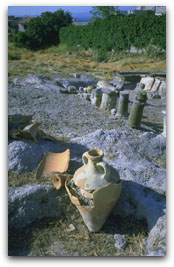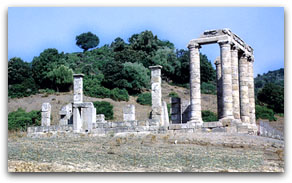During the last centuries of the
nuragic civilisation, along the coast of the Island the Phoenicians founded their first colonies:
Sulci, today's Sant'Antioco, Karalis on the site of the current capital of Sardinia, Nora and
Bithia not far from Cagliari and Tharros in the Province of Oristano. In the VI century BC the
Carthaginians took the place of Phoenicians in the above centres. In about 510 BC, after
various straggles, the Carthaginians managed to conquer Sardinia, setting up a complex
defensive system in order to control the main means of communication between the coast and
the inland areas and the places of particular economic interest. An example of this are the fortresses
of Monte Sirai
and Pani Loriga that controlled the plentiful mineral resources in the
Sulcis-Iglesiente. Although there is some superimposition by the Roman Age, the principal
Punic cities of Tharros, Nora and Sulci, allow the visitor to see, in magnificent surroundings,
the original urban complexes, the most important cult sites, temples, tophets and
necropolis.
|
|

 Sant'Antioco - Tophet Sant'Antioco - Tophet |
In 238 BC Sardinia became a Roman
province, and the new conquerors, in order to impose their rule had to face the hostility and
the resistance of the Sardinian-Punic people, who continued their cultural traditions for a long
time. However Romanization took place during the 7 centuries of Roman occupation. Many
signs of this Romanization can be seen in the architectural patrimony of the
Island.
|

 Cagliari - Roman amphitheatre Cagliari - Roman amphitheatre |
|
In Cagliari one can see: an
Amphitheatre dating from the 2nd century AD, whose main elements are carved out of the rock
which can accomadate an audience of about 10.000 people and nowadays is used for opera
performances during the summer; The Villa di Tigellio attributed to the Latin poet, who was a
native of Sardinia and was mentioned by Orazio and Cicerone and also the evocative "Grotta
della Vipera" in which there are some inscriptions in Latin and Greek representing the
sacrifice of a woman for her husband.
|
Also in many other places on the
Island signs of Romanization can be found: thermal baths, necropolis, private houses and
temples, mostly belonging to the Imperial Age. But there is a monument that most synthesizes
the course of populations and civilisations, the continuity, despite some differences, of
Sardinian culture: the "Temple of Antas", not far from Fluminimaggiore. The building was
restored under Caracalla in 213 AD, it began as a Punic sacellum and, perhaps, before that
was a cult site dedicated to a local God, as some small bronzes of the Nuragic Period
testify.
|
|

 Fluminimaggiore - The Temple of Antas Fluminimaggiore - The Temple of Antas |
The pronaos of the Roman renovation
has four columns that support a frieze on which can be seen a Latin dedication to Sardus
Pater, the traditional God of ancient Sardinia, that the various Punic epigraphs found in this
lace identify as the Punic God called Sid. So the Roman conquerors wanted to respect the
religious patrimony of the Sardinian inhabitants, who were militarily and politically conquered,
but still proud of their own culture and confident, as they are today, of their past vitality that is
still alive in their traditions and memories.
|
|